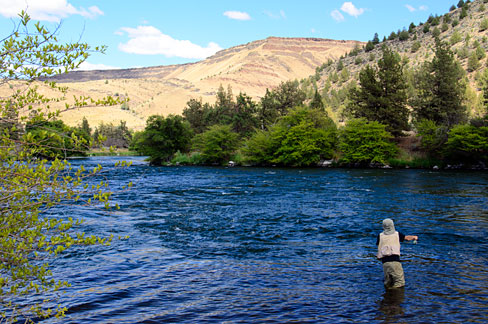Prof. Rohlf’s reflections on Environmental Species Act at 40 symposium
Fish played a prominent role in the Lewis & Clark Animal Law Journal’s recent symposium, which celebrated the Endangered Species Act’s 40th anniversary. Only 5 years after the ESA’s passage in 1973, a young law professor’s love of flyfishing helped convince him to use the statute in an effort to save one of the last free-flowing streams in the southeastern United States from an ill-advised dam development scheme concocted by the powerful Tennessee Valley Authority.
Open gallery

Deschutes river photo: Gary Halvorson, Oregon State Archives
Fish played a prominent role in the Lewis & Clark Animal Law Journal’s recent symposium, which celebrated the Endangered Species Act’s 40th anniversary.
Only 5 years after the ESA’s passage in 1973, a young law professor’s love of fly fishing helped convince him to use the statute in an effort to save one of the last free-flowing streams in the southeastern United States from an ill-advised dam development scheme concocted by the powerful Tennessee Valley Authority. Zyg Plater took the case all the way to the U.S. Supreme Court, which ruled that completing the dam would be illegal. Today, the Court’s ruling in TVA v. Hill is widely regarded as one of the most influential judicial decisions in environmental law.
The promise of a fly fishing trip to Oregon’s Deschutes River convinced Professor Plater to serve as the keynote speaker at the Animal Journal’s annual symposium, held on October 4th at Lewis & Clark. Plater recounted the story of the efforts to save the Little Tennessee River and the snail darters that called it home, following speakers that explored issues such as the ESA’s treatment of climate change, recent litigation under the law, and the intersection of law and science in protecting imperiled species.
The Animal Law Journal will publish articles connected with issues explored at the symposium in its Spring 2014 issue.
More Environmental, Natural Resources, & Energy Law Stories
Environmental, Natural Resources, and Energy Law is located in Wood Hall on the Law Campus.
MSC: 51
email elaw@lclark.edu
voice 503-768-6649
Environmental, Natural Resources, and Energy Law
Lewis & Clark Law School
10101 S. Terwilliger Boulevard MSC 51
Portland OR 97219

